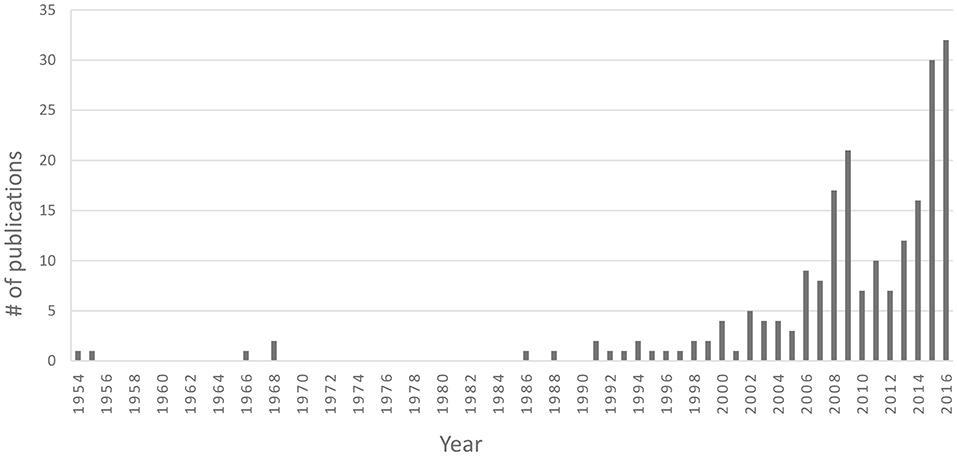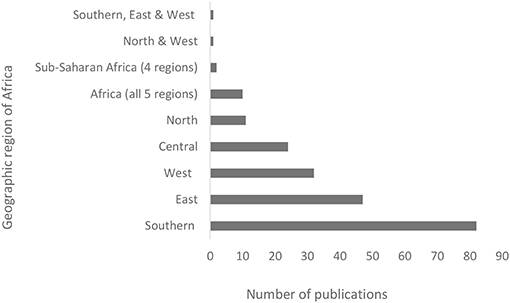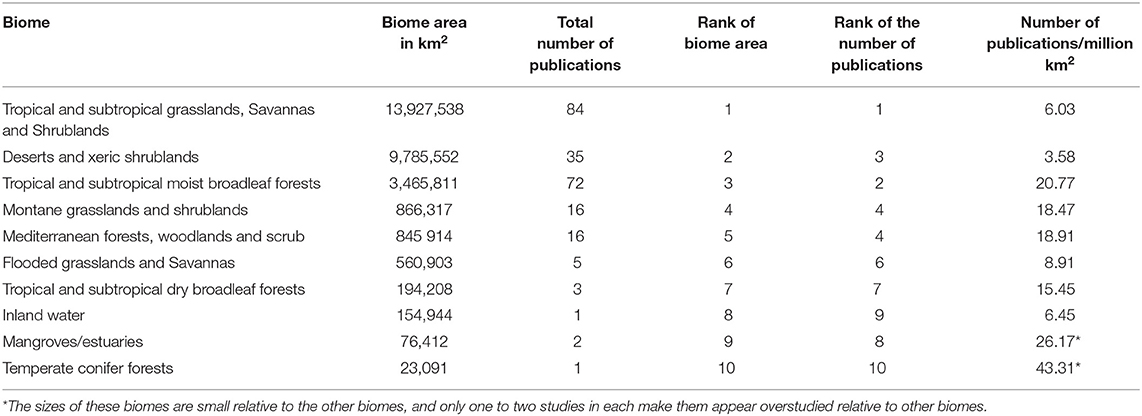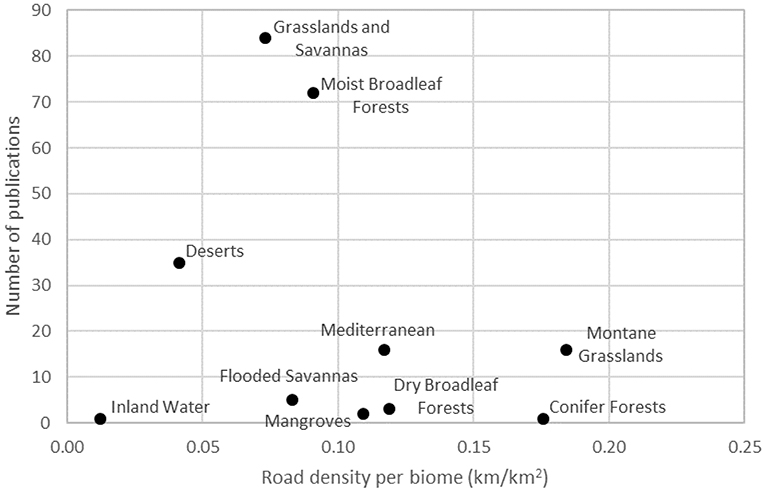- 1Endangered Wildlife Trust, Johannesburg, South Africa
- 2Eugène Marais Chair of Wildlife Management, Mammal Research Institute, University of Pretoria, Pretoria, South Africa
- 3Ecology and Infrastructure International, Wantirna, VIC, Australia
- 4School of BioSciences, The University of Melbourne, Melbourne, VIC, Australia
Across Africa, transport infrastructure, including roads, is being built in over 30 planned development corridors that are likely to have major impacts on remaining natural habitats and associated biodiversity. Linked to this is the projected increase in human population size, which is predicted to grow by 1.3 billion people by 2050. Road ecology is the study of the ecological effects (both positive and negative) of roads and traffic but is perceived to be under-researched in Africa. In this context, we undertook a systematic review of road ecology research in Africa to understand the geographic and taxonomic scope of work undertaken to date, as well as recommendations for reducing the impacts of roads. We discovered 210 road ecology publications from Africa (published between 1954 and 2016), with most publications from the more affluent and politically stable regions (e.g., southern and East Africa). We found more publications than expected, with relevant research concealed within studies whose primary focus was on other topics. Most publications (1) focused on single species, and in particular on mammals (where chimpanzees and forest elephants were most studied); (2) were from southern Africa; and 3) were conducted in the grassland and savannah biome and the tropical and subtropical forest biome. Most publications examined the direct impacts of roads, in particular wildlife-vehicle collisions. Only one-third of the publications provided some form of recommendation for intervention to reduce or mitigate the impacts of roads, based on evidence from the publication. Most recommended interventions related to ecosystem or natural process recreation, as well as site and area stewardship. Gaps and future directions for research include rigorous testing of measures to mitigate the impacts of roads, inclusion of traffic monitoring in studies, understanding the impacts of upgrading roads, and exploring livelihood, economic and moral incentives and education and training as potential interventions for reducing the impacts of roads. Our review has highlighted the need for accelerating the study of the impacts of roads on natural habitats and biodiversity, in light of planned large-scale infrastructure development, and especially the study of appropriate mitigation measures that can be rigorously assessed and implemented before and during construction and upgrading of roads in Africa.
Introduction
Roads are a critical element of human economic development and society, and global rates of road construction will likely rise for the foreseeable future, particularly in Africa, Asia and South America (Dulac, 2013; Laurance et al., 2014a). Roads and traffic have numerous, diverse—and mostly negative—consequences for biodiversity and ecosystem functioning. These impacts include the destruction and degradation of habitat (Laurance et al., 2015a; Ware et al., 2015), fragmentation of wildlife populations and their dynamics (Forman and Alexander, 1998; Ascensão et al., 2016; Chen and Koprowski, 2016), direct impacts through collisions with wildlife (Collinson et al., 2014; Seo et al., 2015; Son et al., 2016), and secondary impacts through increased access by people to previously unattainable natural resources (Wilkie et al., 2000; Vanthomme et al., 2013; Laurance et al., 2014b). The science of road ecology is well-developed in North America, Europe and Australia (Van Der Ree et al., 2015; Bennett, 2017), but is in its infancy in Africa (Bennett, 2017).
Across Africa, much of the major transport infrastructure is being built as part of “development corridors” (Laurance et al., 2014b, 2015a), comprising networks of roads, railways, pipelines, and ports, that facilitate the movement of people and commodities. There are over 30 development corridors planned across Africa, spanning over 53,000 km in length, and potentially affecting protected areas with high conservation value (Laurance et al., 2015b; Sloan et al., 2017). For instance, the proposed Cross River Calabar-Ikom-Kastina Ala Superhighway in Nigeria will effectively bisect some of Nigeria's last remaining intact forests (Mahmoud et al., 2017), and a proposed road to the gold fields near Lake Victoria in Tanzania could bisect the Serengeti National Park and disrupt one of the world's greatest remaining migrations of terrestrial wildlife (Haas, 2011). That these developments are being considered within areas of such high conservation and cultural value reflects a broader, concerning trend across Africa as a whole, whereby natural-resource extraction and related transportation-infrastructure development are often seen as the priority land-use, regardless of other factors (Mahmoud et al., 2017). Successful movement of individual organisms is critical to a species' survival and facilitating these movements by promoting ecological connectivity has become a central theme in ecology and conservation (LaPoint et al., 2015).
In this context, we systematically reviewed the scale, scope, and geographic extent of road ecology research in Africa to quantify the current knowledge and identify gaps and priorities for future research, management and policy formulation.
Materials and Methods
Study Area and History
With 1.3 billion people (United Nations Statistics Division, 2017), Africa accounts for ~17% of the world's human population, making it the second largest and second most-populous continent (behind Asia in both categories). More than half of the anticipated growth in global population of ~2.2 billion people by 2050 (United Nations Statistics Division, 2017), is expected to occur in Africa, with a projected increase of 1.3 billion people (United Nations Statistics Division, 2017). With 41% of sub-Saharan Africans living in extreme poverty (United Nations Statistics Division, 2017; Oluwatayo and Ojo, 2018), this is coming at a time that the Sustainable Development Goals (SDGs) are gaining global traction, with economic growth and poverty reduction taking centre stage in most global policy discourse.
Driven largely by their abundant natural resources, several African economies are among the world's fastest growing as of 2014 (Taylor, 2014), and this is reflected in expansion plans for road, rail and energy transmission lines, with high concentrations of such projects slated to occur in environmentally sensitive areas (The African Development Bank, the African Union and the United Nations Economic Commission for Africa, 2016). The Programme for Infrastructure Development in Africa (PIDA; The African Development Bank Group, 2010), which was launched in 2010, Agenda 2063 (launched in 2015; African Union Commission, 2015), and a joint Memorandum of Understanding (MoU) signed by the World Bank, the Fédération Internationale de l'Automobile (FIA), and the International Transport Forum (ITF) in 2018 (World Bank, 2018a), all provide specific frameworks and funds to improve and support Africa's infrastructure networks and services over the next 50 years. China alone is currently investing ~US$100 billion annually in Africa for extractive mineral industries and associated transportation and energy infrastructure (Edwards et al., 2014), and while Agenda 2063 recognises that there will be “environmental challenges” associated with growth, there is little evidence in place to plan or implement mitigation of these impacts (Politzer, 2008; Laurance and Arrea, 2017).
Literature Search Methodology
We undertook a systematic literature search to investigate the scale, scope and geographic extent of road ecology research in Africa. Three searches were carried out by topic via the “sci-expandable” collection of journals in the ISI Web of Science Database (accessed 18 November 2015, 16 November 2016, and 29 April 2017). We used a formulaic search equation (e.g., = statutory region AND infrastructure type AND ecology impact or intervention), where “statutory region” referred to Africa or any official country in Africa; “infrastructure type” was road, rail, railway, train, vehicle, or transport; and ecological impact or mitigation was ecology, environment, barrier, roadkill, road-kill, wildlife vehicle collision, WVC, wildlife, biodiversity, fragmentation, road effect zone, or mitigation. We reviewed publications that included the most recent developments that were related to some aspect of roads, either solely, or in combination with other linear infrastructure. Publications whose sole focus was other linear infrastructure (e.g., rail or power lines) were excluded.
We elected to include only peer-reviewed papers, post-graduate university theses, conference proceedings, book chapters and reports, all written in English. We first removed duplicate records of those accessed on 18 November 2015, and then vetted the remaining publications (n = 4,257) for relevance based on title, abstract and key words, resulting in 150 relevant publications, relating to roads. These were divided equally amongst the four authors for review. We also each reviewed four publications assigned to other co-authors (i.e., a total of 16) to ensure consistency in the interpretation of the study details.
We reviewed the citations in each of the 150 publications to identify additional publications that met our search criteria. Secondary publications with keywords such as “anthropogenic,” “human-wildlife conflict,” “vehicles,” and “traffic” were also included, as it was probable, based on our experience with the first literature search process, that they may be related to roads or traffic. We excluded publications about “deforestation,” “mining” and “spatial organisation of wildlife” unless their title also specifically included words to suggest some aspect of linear-infrastructure-development that may have been an explanatory variable. This process revealed a further 32 publications (from a total of 231; accessed 16 November 2016). We undertook a final search to account for literature published in 2016 (accessed 29 April 2017), with 28 publications out of a possible 1,356 deemed relevant, bringing the total final database to 237 publications. Of these, we excluded 27 from the final review, either because we could not locate a physical or electronic copy of the publication, or because the citation was incorrect. In such cases, we attempted to contact the primary author and obtain the publication directly from them, all without success (Supplementary Material 1).
We categorised the remaining 210 against criteria to describe the scope, scale and geographic extent of road ecology research in Africa (Supplementary Material 2). This included the country and geographic region of study, species and ecosystem(s) of focus, type of linear infrastructure, study design and type of impact, and whether they examined specific interventions aimed at mitigating impacts. Ten publications had a global or continental focus and were excluded from this analysis. The remaining 200 publications were classified according to the biome in which they occurred (Olson et al., 2001) (Figure 4). The biome of each study was assigned using that given by the author, or if absent, based on the location of the study.
We examined which variables could be related to the number of publications from each country. We hypothesised that the road density [in km of road/100 km2, calculated using the Global Roads Open Access Data Set; CIESIN (Center for International Earth Science Information Network, Columbia University), and ITOS (Information Technology Outreach Services, University of Georgia), 2013] in that country or the Human Development Index (HDI; UNDP, 2018) or the Gross Domestic Product per capita (GDP in purchasing power parity; World Bank, 2018b) (Figure 4) could predict the number of publications produced per country. GDP and the HDI were highly correlated variables (Kendall's rank correlation z = 7.00, p < 0.001). Therefore, we excluded GDP from the analysis. To test for a relationship between the number of publications (corrected for population size, World Bank 2017) and HDI or road density, we fitted a negative binomial regression to the data, as the variance was significantly larger than the mean.
Publications that provided management recommendations that were based on evidence produced during the study were categorised using The Open Standards Conservation Actions Classification v 2.0 (CMP: Conservation Measures Partnership, 2016a,b). This is a standard classification of the conservation actions that managers can take to counter direct threats and was jointly developed by the International Union for Conservation of Nature (IUCN) and the Conservation Measures Partnership. The CMP provides systematic guidance about planning, implementing, and monitoring conservation initiatives to understand what works, what does not work, and why, and ultimately adapt and improve conservation efforts. In the context of our review, it served as a tool to measure the recommendations of each publication, based on evidence produced during the study, and highlight critical knowledge gaps. The classification consists of four hierarchical levels of action, with level 0 being the broadest overarching level with three categories, and level 3 containing the most detail (Supplementary Material 3).
Once classified, we assessed each recommendation against seven categories based on the Quality of Evidence (Salafsky et al., 2002), allowing for comparison across studies through quality control criteria. We recorded the categorisation results in a simple database to identify any trends (Supplementary Material 2).
We used R 3.5.0 (R Core Team, 2018), with the MASS, ggplot2, and ggpubr packages, for statistical analyses.
Results
Study Type
Of the 210 publications, most focused on gathering empirical field data (166 or 79%). Of the remaining 21%, 14 were reviews of published literature, 13 presented conceptual ideas, and the remaining 17 were a combination of the three study types.
Publication Type
Most publications were from peer-reviewed journals (88.6%), followed by theses (5.7%), book chapters (4.3%), reports to government agencies (1%) and conference proceedings (0.5%). The 185 peer-reviewed publications were published in 95 different journals, of which 12 were specific to Africa. The most frequent source journals were African Journal of Ecology (n = 12), Biodiversity and Conservation (n = 11), PloS One (n = 10), Ostrich—Journal of African Ornithology (n = 9), and Ecology (n = 7).
Of the 12 theses, most were from a Bachelor of Science (Honours) degree (n = 7), followed by Master of Science or Philosophy (n = 2) and a Doctorate (n = 3). Most theses were undertaken at African universities, with nine from South Africa and one from Tanzania. Two theses came from universities outside of Africa (Norway and the United States). We found nine chapters from three different books, with the Handbook of Road Ecology (Van Der Ree et al., 2015) containing seven of the nine chapters. The three reports were from two countries, South Africa (n = 2) and Tanzania (n = 1), whilst the conference proceedings were from a conference in the Czech Republic in 2016 regarding photogrammetry, remote sensing and spatial information sciences.
Temporal Patterns
Publications were published between 1954 and 2016, with 169 published in the past decade (2006–2016), and just over half (n = 114) published in the past 6 years (2010–2016; Figure 1). Only 20 (9.5%) publications were published over the 45-year period between 1954 and 1999.
Spatial Patterns in Published Road Ecology Research
Almost all publications (n = 196) were conducted entirely in one of the five sub-regions of Africa (Supplementary Material 4), whilst 14 publications were more generic and covered Africa as a whole (4.8%; Figure 2). Southern Africa was the most studied region (37.1%), followed by East Africa (24.2%), West Africa (18.8%) and Central Africa (14.8%). North Africa was the least represented of all the regions in Africa, with just 5.1% of the publications. Most studies (n = 173; 82.4%) were conducted in only one country, although two studies spanned seven African countries.
Approximately two-thirds (Figure 3; Supplementary Material 4) of the publications were conducted in just seven countries, namely South Africa (n = 66), Tanzania (n = 21), Cameroon (n = 17), Gabon and Kenya (n = 16 each), -Democratic Republic of Congo (n = 15), and Central African Republic (n = 14).
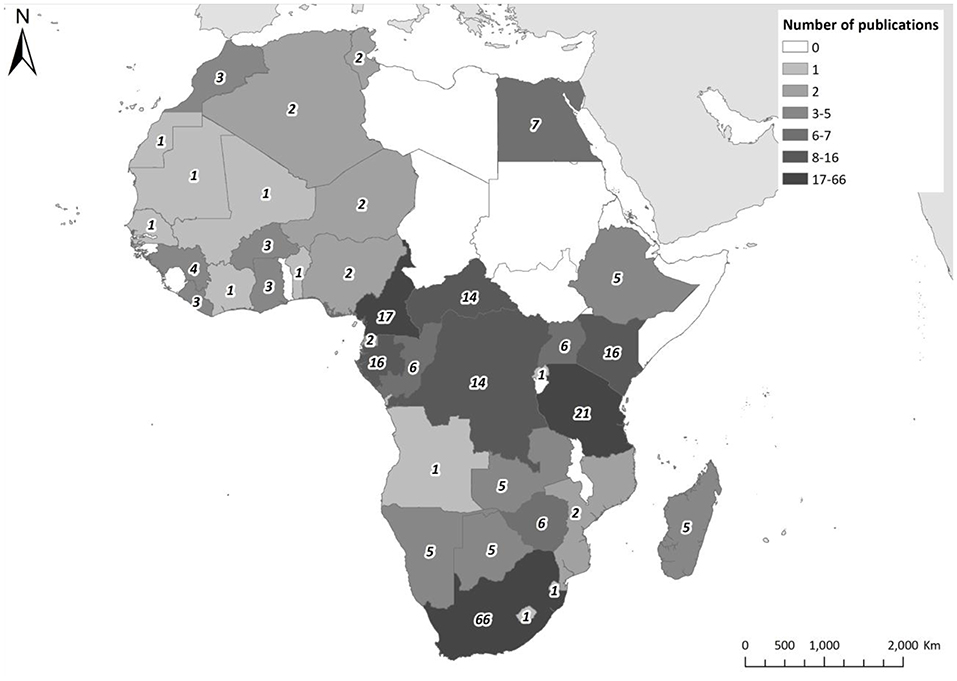
Figure 3. The number of road ecology publications per country in Africa between 1954 and 2016 (publications covering multiple countries are shown in each country's total).
The earliest publications were conducted in Zimbabwe in the 1950s (Supplementary Material 5), with little further research anywhere in Africa being undertaken until the 1980s (again in southern Africa). It was only in the late 1990s that publications in the other geographic regions were published (Supplementary Material 5).
We found that there was no relationship between the number of publications per country and road density (p = 0.76), but that countries with a higher HDI had published a larger number of studies (p = 0.01; Figure 4).
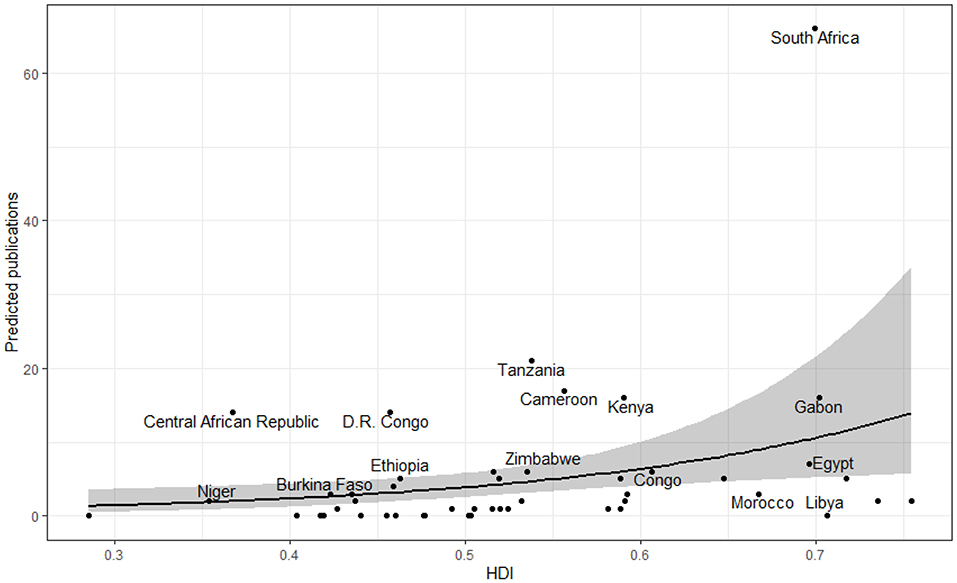
Figure 4. Predicted number of publications per country plotted against the Human Development Index of that country. The grey shading represents the 95% CI.
Biome
Of the 200 publications that we could assign to a biome (i.e., that were not continent-wide studies), 21 covered two biomes, while seven covered three biomes. The remaining 172 publications covered a single biome.
Most publications were conducted in tropical and subtropical grasslands, savannas and shrublands (Table 1). This biome is the largest in Africa, covering ~14 million km2. Although 35 publications were conducted within the deserts and xeric shrublands biome, relative to its total area, this was the least studied biome, with only 3.58 publications per million km2 (Table 1).
Tropical and Subtropical Grasslands and Savannas, and Moist Broadleaf Forests were relatively more studied in relation to their road density than Mediterranean, Dry Broadleaf and Conifer Forests, and Montane Grasslands (Figure 5).
Dominant Land-Use
Most publications were from rural areas, which we defined as including natural areas and agricultural landscapes (n = 144; 68.6%), with 33 (15.2%) being undertaken in both rural and urban areas. Just 10 publications were from urban areas (4.8%), with land-use information not provided for the remaining 14 (6.7%). Furthermore, our initial search revealed that studies undertaken in urban areas were more likely to consider human wellbeing rather than the environment per se.
Just under half of the publications were from outside of protected areas (42.9%), followed by inside of protected areas (32.4%) or a combination of both (16.7%), with the remaining 8.1% unspecified. The estimated percentage of terrestrial protected areas in sub-Saharan Africa is 16.43% (World Bank, 2018b). Thus, the percentage of road ecology studies that were conducted inside protected areas is significantly higher, relative to land area than outside (Chi-squared single variable goodness of fit text, χ2 = 81.5, p < 0.01).
Most publications from within protected areas were undertaken in East Africa (38.4%), followed by southern Africa (34.2%), West Africa (15.1%), Central Africa (9.6%), and North Africa (1.4%). The remaining 1.4% accounted for generic studies encompassing the entire continent.
Ecological Focus of Study
Of the 210 publications, 60.5% focused on animals (vertebrates and invertebrates), followed by ecosystems (21.0%), plants (16.7%), and a combination of animals and plants (1.0%). Most animal publications were conducted on vertebrates (n = 116) with five publications on invertebrates and four on a combination of the two (Supplementary Material 6). Six publications focused on a combination of animals and plants with 35 publications focusing solely on plants. The remaining 44 publications focused on ecosystems, of which land-use change was the most studied topic (n = 21) (Figure 6).
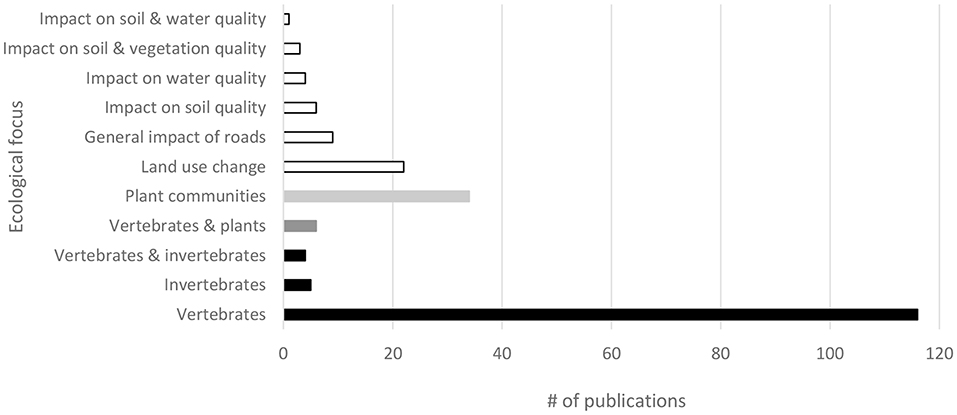
Figure 6. The ecological focus of 210 road ecology publications, according to broad ecological groupings (black bars represent animals, dark grey bars represent animals and plants, light grey bars represent plants and white bars represent ecosystems).
More publications focused on individual species (n = 112) than multiple species (n = 53) for both the animal and plant Kingdoms. Mammals were the most studied terrestrial (n = 43) vertebrate group (n = 98), while amphibians were the least studied (n = 1) (Supplementary Material 6).
Most plant-focused publications centered on indigenous forest (both individual-species and communities; n = 16), with most being in Central Africa (n = 11), followed by alien and invasive plants (n = 10), with the remaining nine focusing on general plant communities, such as grasses (Rahlao et al., 2010) and roadside vegetation cover (O'Farrell and Milton, 2006).
We found that the chimpanzee (Pan troglodytes veru; n = 10) was the single most studied species, followed by the Forest Elephant (Loxodonta africana cyclotis; n = 8) (Table 2), both of which are resident in Central African countries.

Table 2. The species most commonly the focus of road ecology publications with five or more studies from the 210 reviewed publications for road ecology in Africa.
Type of Infrastructure
Most publications (n = 173) focused solely on the impact of roads only, while 37 also included the impacts of other types of linear infrastructure. These included roads and fencing (n = 18), roads and rail (n = 8), roads and power lines (n = 6) and roads and pipelines (n = 5).
Ninety-two of the publications did not specify the purpose of the road, while 54 stated it was for general (i.e., day-to-day) usage, followed by primarily industrial (e.g., mining and logging) (n = 25), tourism (n = 19), and agricultural (n = 2) uses. Three publications stated that the road was also used by pedestrians. The remaining 15 publications were a combination of the three types: general and industrial (n = 8), general, industrial and tourism (n = 4), industrial and tourism (n = 2), and general and tourism (n = 1).
Only 39% of the publications provided data about the road surface, with 11.9% of these focussing solely on unpaved roads, 10.5% focussing on paved roads, and 15.2% conducted on a combination of the two surfaces. The remaining 1.4% (n = 3) were for other surfaces (e.g., sand and off-road). Only 20% (n = 42) of publications measured traffic volume and/or vehicle speed.
Study Design
Study Focus on Linear Infrastructure and Explanatory Variables
Linear infrastructure itself was the primary focus of just under half (44.8%) of the publications we reviewed. In most publications (71.4%) the linear infrastructure was used as an explanatory variable, showing causes or impacts of linear infrastructure on other (i.e., dependent) variables.
Among those publications that measured direct impacts on biodiversity (n = 190), those that examined wildlife mortality due to collision with vehicles were the most numerous (n = 58). Thirty-seven publications investigated the impact of roads on roadside vegetation and/or habitat, and 30 examined the impact of roads on the behaviour of animals near or crossing roads (Figure 7).
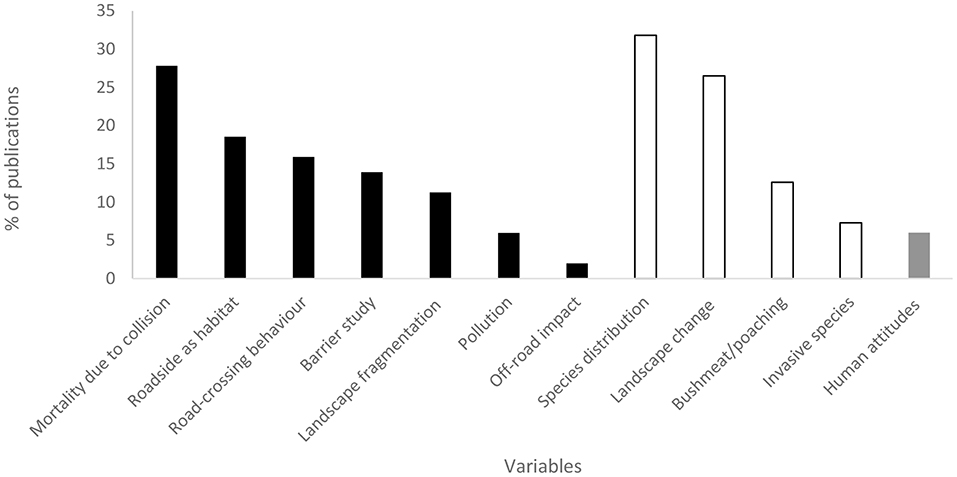
Figure 7. The percentage of publications assessing different impacts of linear infrastructure (black columns represent direct impacts, white columns represent indirect impacts and grey columns represent human attitudes).
For publications addressing the indirect impacts of roads and traffic (n = 161), most used a measure of road length or density to explain the distribution of species (n = 67; 31.8%). Of the remaining publications, 54 examined changes in the landscape due to the presence of roads (Figure 7), such as changes caused by fire (Archibald et al., 2009) or clearance of forests due to logging (Christie et al., 2007).
Nine of the 210 publications studied human attitudes and their behaviour in relation to roads (Figure 7). These were all undertaken during the last 16 years, with four undertaken in southern Africa, two each in East and Central Africa, and one in West Africa. Five of these publications examined public perceptions of how linear infrastructure changes a landscape, three studied human attitudes to wildlife on roads and the possible causes of roadkill, and one addressed public opinions of methods to mitigate roadkill. The remaining publication focused on factors that increase a visitor's game-viewing experience in a protected area, with well-designed roads being a factor.
Study Design and Methods of Analysis Employed
More than half of the publications (n = 120) adopted study site replicates as their main method of study design, followed by site comparisons (n = 95), with only ten publications conducting a before-and-after-trial (Figure 8). Most studies analysed the data using correlations (Figure 8; n = 155) compared to simply reporting results or observational data without any formal analysis (n = 61), whilst 16 used both correlative and observational approaches (a single publication can employ several approaches).
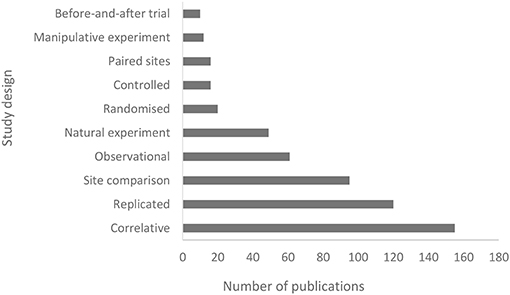
Figure 8. Study design elements of 210 road ecology publications. Studies can combine several elements and therefore the total is >210.
Recommendations and Associated Quality of Evidence
Only seven of the 210 publications evaluated the effectiveness of interventions, such as measuring rates of use of an elephant underpass in Kenya (Weeks, 2015). Four of these seven studies were in East Africa (Kenya, n = 3; Tanzania, n = 1) and three in South Africa.
Three quarters of publications provided some form of recommendation for intervention, although only 30.5% of these (n = 64) contained recommendations that were based on any evidence from the published study itself, amounting to 133 evidence-based recommendations overall. The remaining publications with recommendations contained general or “conventional wisdom” recommendations that could a priori have been applied to almost any road ecology study anywhere in the world. Most recommendations (based on evidence from within the publications) came from studies from southern Africa (40.6%), followed by East Africa (24.6%), Central and West Africa (both 14.5%), and 5.8% for Africa, as a whole. No recommendations were found from North Africa.
We classified 133 different evidence-based recommendations for intervention from 64 publications according to the Open Standards Conservation Actions Classification v 2.0. Most of the recommendations proposed target restoration or stress reduction actions (CMP, Level A; Figure 9) followed by enabling conditions (CMP, Level C), and behavioural change or threat reduction actions (CMP, Level B). Within these primary levels, the category A1 (land/water management) had the most recommendations (37.6%; Figure 9), followed by the category C6 (conservation designation and planning; 20.3%; Figure 9) and B3 (awareness raising; 15.8%; Figure 8).
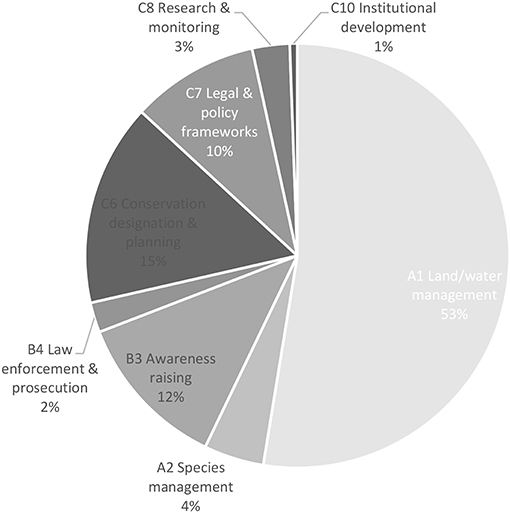
Figure 9. The percentage distribution of the 133 recommended interventions (from 64 publications) classified according to the Conservation Measures Partnership (CMP; Conservation Actions Classification v 2.00 Framework Levels 1–2; Supplementary Material 3). Note that a single paper can employ several approaches.
Level 2 categories of the CMP shows ecosystem and natural process recreation (A1.2) having the most recommendations for intervention (37.6%; Figure 10) followed by site/area stewardship (A1.1; 31.6%), outreach and communications (15.8%; B3.1) and site infrastructure (11.3%; C6.5). Four publications within category B3 did not provide details of how the intervention should be undertaken and could not therefore be categorised further than Level 1.
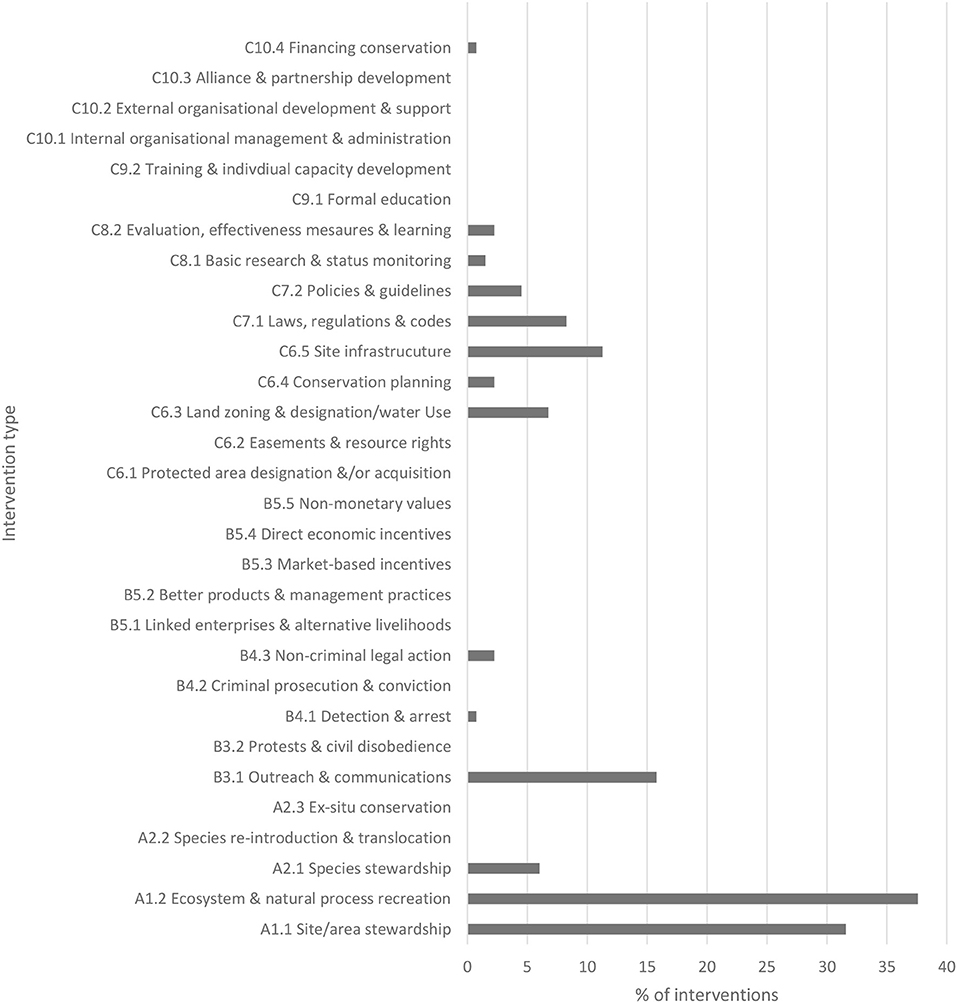
Figure 10. The distribution of the 133 recommended interventions (from 64 publications) for Level 2 of CMP A (Target Restoration/Stress Reduction Actions), CMP B (Behavioural Change/Threat Reduction Actions), and CMP C (Enabling Condition Actions), classified according to the Conservation Measures Partnership (CMP; Conservation Actions Classification v 2.00 Framework Level 3; Supplementary Material 3). Note that a single publication can recommend several approaches.
Whilst there were many recommendations spanning the three broad CMP categories, there were also gaps for recommendations from many of the CMP classification levels, such as CMP Level B5 (Livelihood, Economic and Moral Incentives) and CMP Level C9 (Education and Training) (Figure 10).
The final level of the CMP Framework (Level 3) categorises recommendations for intervention, with visitor management (A1.1.8) having the highest number of recommendations (14.7%). Examples of CMP category A1.1.8 include restricting vehicular road usage (Ndibalema et al., 2008; Nortjé et al., 2012), and diverting future roads or locating roads away from protected areas (Ansara, 2008; Van Vliet and Nasi, 2008). This category was followed by mechanical actions (12.4%; A1.1.1;) including better management of roadside verges (Rahlao et al., 2010; Mkanda and Chansa, 2011), and cleaning of vehicles prior to entry and use within areas of high conservation values such as national parks, to avoid spreading alien and invasive plants (Ansong and Pickering, 2013). Transport was the third most common category (11.6%; C6.5.4) with examples including the installation of traffic-calming devices (such as speed bumps) at identified roadkill “hotspots” Drews, 1995; Hayward, 2009 and limiting future road upgrades through maintaining the unpaved road surface (Caro, 2015).
Our assessment of the quality of evidence showed that most recommendations (93.3%) were based on quality of evidence of levels I to III (Table 3), but <10% of the recommendations were based on studies that conducted a controlled trial (level I). Most recommendations were from publications that compared sites (level II-2; 44.8%) or temporal patterns (level II-3; 19.4%) and 15.7% of recommendations were based on expert opinions or descriptive studies (level III). We deemed the evidence in the remaining 6.7% of recommendations to be inadequate (level IV) or we were unable to assess the quality of evidence (NC) (Table 3).
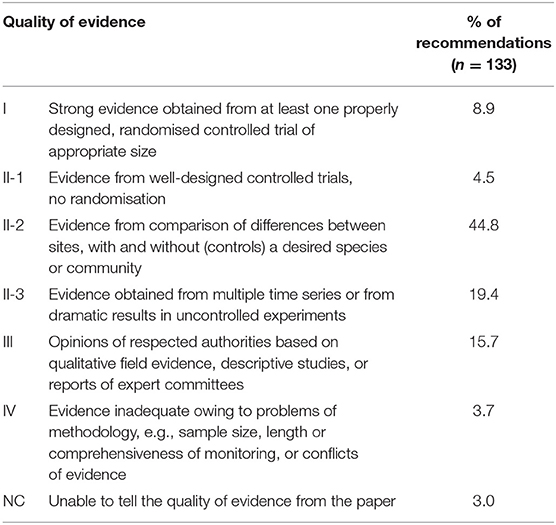
Table 3. The quality of evidence for the 133 evidence-based recommendations from the 64 publications that provided recommendations for interventions (Salafsky et al., 2002).
Discussion
Summary
Our review revealed many more road ecology publications from Africa than we expected, with a significant increase in the number of publications since 2006. Most of the publications were from the more affluent and politically stable regions (e.g., southern and East Africa), particularly pre-2006 publications (Drews, 1995; Dean and Milton, 2000), whilst post-2006 publications saw an increase in the number of papers from Central Africa (Hicks et al., 2012; Tompkins et al., 2015; Cameron et al., 2016).
A recent global review of road ecology papers published between 2011 and 2015 (Bennett, 2017) found that <10 studies (n = 215) were conducted in Africa. Consequently, there is a perception that few road ecology studies have been undertaken in Africa (Collinson et al., 2014, 2015; Kioko et al., 2015) possibly because earlier literature searches have been too narrow or too specific in the focus. We used broad search terms in our review, and thus discovered many more publications than Bennett (2017). We also found that many road ecology studies were hidden or buried in studies that were ostensibly on other topics, for example, where road density was an explanatory factor to help understand the distribution or abundance of a certain species, and not the primary focus (e.g., Blom et al., 2005; Aubréville, 2015; Bortolamiol et al., 2016).
We outline below some key points drawn from the literature that highlight future research priorities.
Threats to Habitats and Species
By definition, all of the publications we reviewed focused solely on roads (e.g., Collinson et al., 2014; Kleinschroth et al., 2016) or jointly on roads with another type of linear infrastructure (e.g., roads and fencing, Van Niekerk and Eloff, 2005; roads and rail, Watson et al., 2015; roads and power lines, Laurance et al., 2009; roads and pipelines, Akert, 2015). We found limited research comparing paved vs. unpaved roads (but see, Awange and Obera, 2007; Collinson et al., 2014), and most publications (~two-thirds) gave no indication of the surface of the roads they studied. This highlights a critical gap in the research, given the extensive unpaved road network in Africa. The global road network is ~64 million km, with ~2.7 million km in Africa, three-quarters of which are unpaved [Central Intelligence Agency (CIA), 2013]. Globally, 12 million km of paved roads have been built since 2000 with another 25 million lane-km projected to be built by 2050 (Dulac, 2013), many of which are planned for Africa. It would therefore be logical to devote resources to examining before-and-after studies in light of many of these unpaved roads targeted for upgrade (Dulac, 2013), while accounting for other changes associated with paving, such as increased traffic volume and vehicle speeds. We found few studies that measured traffic volume and/or vehicle speed (but see Mouhoub Sayah et al., 2009; Collinson et al., 2014) and, in light of increased road expansion and the resulting increase in traffic volumes, we recommend that future research incorporates traffic monitoring surveys to obtain baseline estimates and track changes over time.
We found a shift in study focus across the continent in the last decade, from species distributions to that of landscape change (e.g., Maeda et al., 2010; Nortjé et al., 2016), specifically in Central Africa (e.g., Laporte et al., 2007; Kleinschroth et al., 2016). This is unsurprising given that this region of Africa has been recognised in recent years as a “conflict zone” (Laurance et al., 2014a), with high environmental costs accorded to infrastructure development or future impacts of climate change (Laurance et al., 2014a). Furthermore, recognition of the spread of alien and invasive plants, particularly on roadside verges (e.g., Kalwij et al., 2008; Foxcroft et al., 2011) has emerged in latter years as an indirect threat of roads, particularly in South Africa.
Wildlife crime has gained momentum as a topic of international attention and concern in the last few decades (Wilson-Wilde, 2010), with roads facilitating illegal activities such as poaching (Laurance et al., 2014b). We found that 18% of the publications showed evidence of roads facilitating poaching (e.g., Maisels et al., 2013; Shaffer and Bishop, 2016). These studies were specifically in East (e.g., Jones et al., 2009; Kimanzi et al., 2015) and Central Africa (e.g., Wilkie et al., 2000; Haurez et al., 2013), and they primarily focused on mammals, such as the African elephant (Maingi et al., 2012; Shaffer and Bishop, 2016), forest elephant (Blake et al., 2007; Maisels et al., 2013), Western Lowland gorilla (Stokes et al., 2010; Haurez et al., 2013) and Temminck's ground pangolin (Smutsia temminckii, Pietersen et al., 2011). With many of these species classified as threatened (IUCN, 2018a), and with annual estimates of the cost of wildlife crime ranging from US$10–20 billion globally (Wilson-Wilde, 2010), the effort of research undertaken, specifically in these regions, supports the need for an understanding of both habitat and species of concern.
Addressing the Threats
One-third of the publications provided some form of recommendation for intervention, based solely on evidence from the paper, with the remaining publications either making no recommendations, or making recommendations that were too broad, and which neglected to provide evidence directly gleaned from the research. Intervention strategies were often poorly described, lacked operational guidelines and theoretical justification, as well as measurement of data quality, which is common in many disciplines (Salafsky et al., 2002; Becker, 2005; Proctor et al., 2013). The population of some of the conceptual ideas presented in the papers, whilst beyond the scope of this paper is an opportunity for further investigation.
It was apparent that there has either been little or no mitigation of the impacts of roads in Africa, or it has yet to be studied and published (but see Le Brun, 2013; Donaldson and Cunneyworth, 2015; Weeks, 2015). This is in stark contrast to more developed countries in North America (e.g., Clevenger et al., 2001; Sielecki, 2001) and Europe (e.g., Seiler, 2003; van Vuurde and van der Grift, 2005), where literally thousands of interventions have been tested and published since the 1980s (Rytwinski et al., 2016). There are numerous measures for mitigating the negative impacts of roads globally, some of which use existing infrastructure, such as storm drains and culverts beneath roads to assist animals with safer crossings of roads, and thus reducing roadkill (Rytwinski et al., 2016). There are only three African road ecology publications where mitigation has been tested, and therefore provide case studies about wildlife-crossing structures, two in East Africa (Donaldson and Cunneyworth, 2015; Weeks, 2015) and one in South Africa (Le Brun, 2013) although data for the effectiveness of these measures was not measured. A further study in South Africa, which was outside the period of inclusion in our literature search, is the only study in South Africa, that we are aware of, that has assessed the effectiveness of a mitigation measure (Collinson et al., 2017).
Despite the paucity of evidence-based recommendations, most recommendations came from publications within South Africa where most of the empirical and conceptual data was collected. This then begs the question as to why no mitigation has yet been applied, or if it has, when will the results be published? These limitations are not unique to Africa, since Rytwinski et al. (2016) state that there is a paucity, in general, of scientifically rigorous studies on mitigation effectiveness. Furthermore, notwithstanding the evidence of the emerging threats to the Central African forests from industrial logging (Laporte et al., 2007), and therefore, declared a “conflict zone” (Laurance et al., 2014b), the proposed recommendations from the nine publications (Malcolm and Ray, 2000; Blom et al., 2004; Blake et al., 2007, 2008; Clark et al., 2009; Laurance et al., 2009; Epps et al., 2015; Kleinschroth et al., 2015, 2016) should be given urgent priority for implementation and assessment.
Identifying the Gaps
Most of the studies collected basic enumeration roadkill rates (e.g., Dean et al., 2006; Perony and Townsend, 2013) or presented conceptual ideas (e.g., Zhang et al., 2006; Müller and Mburu, 2009). This is often a common feature when undertaking new research within countries and was observed historically in more developed countries such as Britain (Philcox et al., 1999) and North America (Caro et al., 2000), where studies in the field of road ecology first commenced with gathering road mortality data. This is apparent in developing countries beyond the African continent that seek to first gather empirical data (e.g., India, Selvan et al., 2012; China, Yun et al., 2013), and then expand to applying and assessing mitigation measures, as is the case with more developed countries (e.g., USA, Langen et al., 2009; Australia, Taylor and Goldingay, 2010).
With <20% of the papers undertaking a study on human attitudes, it is globally recognised that the integration of the social sciences into long-term ecological research is an urgent priority (Redman et al., 2004; Ingold and Palsson, 2013), none more so when it comes to understanding driver behaviour. Africa is not alone in this limited understanding, and it is only in the last decade that global studies have been undertaken to address this integration (Lester, 2015; Grace, 2017).
Whilst there were many recommendations spanning the three broad CMP categories, there were also gaps for recommendations from many of the CMP classification levels that should be considered for future study, provided they are appropriate. CMP Level B5 (Livelihood, Economic and Moral Incentives) received no recommendations and, as a factor that seeks to provide better products and management practices (B5.2), market-based incentives (B5.3), as well as direct economic incentives (B5.4), this would be a critical area in gaining “local buy-in” and sustainability for environmental work as well as supporting local livelihoods. Likewise, CMP Level C9 (Education and Training) also received no recommendations. Whilst Awareness raising (CMP B3) “touched” on education, it was not specified as formal instruction through school learners or providing technical assistance to project teams (McKinney, 2002).
Not all recommendations are always feasible to implement, based on budget constraints or inadequate environmental impact assessments (EIAs) undertaken during the planning and design stage (Langan, 2015). This, therefore, requires that relevant experts are involved in EIA processes (Fischer, 2007). It also requires governments to recognise the negative impacts of roads on biodiversity, and the benefits to addressing these. It is also critical to be pragmatic in our understanding of which impacts can be successfully mitigated, and those that cannot, and therefore should always be avoided during planning and design stages of projects. This is not an easy task in a continent that is battling to improve its socio-economic circumstances, and where conservation often takes a back seat (Sayre, 1999). Developing centralised repositories of road ecology data, working groups such as the IUCN's Transport Working Group (IUCN, 2018b), and engagement platforms with African infrastructure investors would provide a foundation to addressing critical threats.
Conclusions
Despite the widespread perception that there is a paucity of African road ecology publications (Collinson, 2013; Collinson et al., 2015; Kioko et al., 2015; Bennett, 2017), our literature search revealed a surprisingly large number of studies. Global attention and concern has shifted toward Africa in the last decade since improved stability, abundant resources and increased foreign investment into many African nations have spurred economic growth (Taylor, 2014) and road expansion (The African Development Bank, the African Union and the United Nations Economic Commission for Africa, 2016).
The European Commission has committed to providing African countries with financial support to facilitate poverty eradication and the broader achievement of the United Nations SDGs. According to Laurance et al. (2015b), expanding and upgrading Africa's road network may well improve the continent's socio-economic situation, but negative environmental outcomes could provoke an environmental crisis. EIAs are intended to identify potential risks and liabilities of infrastructure projects, and to minimise such risks with suitable mitigation and offset measures. However, EIAs are often widely seen as too transient to determine the actual environmental costs of new infrastructure projects (Laurance and Arrea, 2017), and the cumulative impacts of roads can lead to negative indirect effects, such as habitat fragmentation (Jaeger, 2015).
Despite our search findings demonstrating more studies than expected, this does not mean that enough has been done. There is still a pressing need for well-designed, basic road ecology studies to be undertaken in Africa, on a wide range of topics. The number and type of recommendations outlined in the studies through using the Open Standards Conservation Actions Classification highlights many areas that were either not studied or had limited study. For example, far more papers alluded to wildlife with few considering areas such as pollution (Inchaouh et al., 2017; Megido et al., 2017), biological invasions or off-roading (see Figures 6, 7). Furthermore, whilst some of the papers described animal behaviour around roads (e.g., road avoidance, foraging near roads; Bortolamiol et al., 2016), a broader search that includes additional terms, specifically “behaviour” will likely source further road ecology-related studies (for example, Shepard et al., 2008; Neumann et al., 2012). Our study has highlighted the need for the accelerated study of the impacts of roads and appropriate mitigation measures, and adoption of recommendations made in the African road ecology publications, so that mitigation be applied and rigorously assessed. We further advocate for a detailed review of the EIA process be undertaken for different African countries focusing on the quality of proposed linear infrastructure projects, with project investors devoting more resources to more robust environmental assessments, with tangible recommendations and solutions.
Author Contributions
WC, HD-M, LR, and RR: project conceptualisation, data analysis and manuscript writing. WC and LR: data collation and cleaning.
Conflict of Interest
The authors declare that the research was conducted in the absence of any commercial or financial relationships that could be construed as a potential conflict of interest.
Acknowledgments
This research was initiated by the Endangered Wildlife Trust, Ecology and Infrastructure International, Wantirna, Victoria, Australia, and the School of BioSciences, The University of Melbourne. Thanks to Lee Harrison for conducting the literature search.
Supplementary Material
The Supplementary Material for this article can be found online at: https://www.frontiersin.org/articles/10.3389/fevo.2019.00479/full#supplementary-material
References
African Union Commission (2015). Agenda 2063. African Union Commission. Available online at: http://www.un.org/en/africa/osaa/peace/agenda2063.shtml (accessed July 19, 2018).
Akert, J. (2015). Risks to ecological systems from hydraulic fracturing in the Nama Karoo, South Africa (Master's dissertation). Wildlife Management in the Centre for Wildlife Management Faculty of Natural and Agricultural Sciences, University of Pretoria, South Africa.
Ansara, T. (2008). Determining the ecological status and possible anthropogenic impacts on the grass owl (Tyto capensis) population in the East Rand Highveld, Gauteng (Doctoral dissertation). University of Johannesburg, South Africa.
Ansong, M., and Pickering, C. (2013). Are weeds hitchhiking a ride on your car? A systematic review of seed dispersal on cars. PLoS ONE 8:e80275. doi: 10.1371/journal.pone.0080275
Archibald, S., Roy, D. P., van Wilgen, B. W., and Scholes, R. J. (2009). What limits fire? An examination of drivers of burnt area in Southern Africa. Global Change Biol. 15, 613–630. doi: 10.1111/j.1365-2486.2008.01754.x
Ascensão, F., Mata, C., Malo, J. E., Ruiz-Capillas, P., Silva, C., Silva, A. P., et al. (2016). Disentangle the causes of the road barrier effect in small mammals through genetic patterns. PLoS ONE 11:e0151500. doi: 10.1371/journal.pone.0151500
Aubréville, A. (2015). In search of the forest in Côte d'Ivoire, parts 1 & 2. Bois For. Tropiques 323, 71–102. doi: 10.19182/bft2015.323.a31247
Awange, J. L., and Obera, B. (2007). Motor vehicles: are they emerging threats to Lake Victoria and its environment? Water Air Soil Pollut. 182, 43–56. doi: 10.1007/s11270-006-9319-3
Becker, T. E. (2005). Potential problems in the statistical control of variables in organizational research: a qualitative analysis with recommendations. Org. Res. Methods 8, 274–289. doi: 10.1177/1094428105278021
Bennett, V. J. (2017). Effects of road density and pattern on the conservation of species and biodiversity. Curr. Landsc. Ecolo. Rep. 2, 1–11. doi: 10.1007/s40823-017-0020-6
Blake, S., Deem, S. L., Strindberg, S., Maisels, F., Momont, L., Isia, I. B., et al. (2008). Roadless wilderness area determines forest elephant movements in the Congo Basin. PLoS ONE 3:e3546. doi: 10.1371/journal.pone.0003546
Blake, S., Strindberg, S., Boudjan, P., Makombo, C., Bila-Isia, I., Ilambu, O., et al. (2007). Forest elephant crisis in the Congo Basin. PLoS Biol. 5:e111. doi: 10.1371/journal.pbio.0050111
Blom, A., Van Zalinge, R., Heitkönig, I. M., and Prins, H. H. (2005). Factors influencing the distribution of large mammals within a protected central African forest. Oryx 39, 381–388. doi: 10.1017/S0030605305001080
Blom, A., Van Zalinge, R., Mbea, E., Heitkönig, I. M., and Prins, H. H. (2004). Human impact on wildlife populations within a protected Central African forest. Afr. J. Ecol. 42, 23–31. doi: 10.1111/j.0141-6707.2004.00441.x
Bortolamiol, S., Cohen, M., Jiguet, F., Pennec, F., Seguya, A., and Krief, S. (2016). Chimpanzee non-avoidance of hyper-proximity to humans. J. Wildlife Manage. 80, 924–934. doi: 10.1002/jwmg.1072
Cameron, K. N., Reed, P., Morgan, D. B., Ondzié, A. I., Sanz, C. M., Kühl, H. S., et al. (2016). Spatial and temporal dynamics of a mortality event among Central African great apes. PLoS ONE 11:e0154505. doi: 10.1371/journal.pone.0154505
Caro, T. (2015). Roads through national parks: a successful case study. Trop. Conserv. Sci. 8, 1009–1016. doi: 10.1177/194008291500800411
Caro, T. M., Shargel, J. A., and Stoner, C. J. (2000). Frequency of medium-sized mammal road kills in an agricultural landscape in California. Am. Midl. Nat. 144, 362–369. doi: 10.1674/0003-0031(2000)144[0362:FOMSMR]2.0.CO;2
Central Intelligence Agency (CIA) (2013). Transportation: World. Available online at: https://www.cia.gov/library/publications/the-world-factbook/geos/xx.html (accessed July 19, 2018).
Chen, H. L., and Koprowski, J. L. (2016). Barrier effects of roads on an endangered forest obligate: influences of traffic, road edges, and gaps. Biol. Conserv. 199, 33–40. doi: 10.1016/j.biocon.2016.03.017
Christie, T., Steininger, M. K., Juhn, D., and Peal, A. (2007). Fragmentation and clearance of Liberia's forests during 1986-2000. Oryx 41, 539–543. doi: 10.1017/S0030605307000609
CIESIN (Center for International Earth Science Information Network Columbia University), ITOS (Information Technology Outreach Services, University of Georgia). (2013). Global Roads Open Access Data Set, Version 1 (gROADSv1). Palisades, NY: NASA Socioeconomic Data and Applications Center (SEDAC). Available online at: https://doi.org/10.7927/H4VD6WCT (accessed August 31, 2018).
Clark, C. J., Poulsen, J. R., Malonga, R, and Elkan, P.W. Jr. (2009). Logging concessions can extend the conservation estate for Central African tropical forests. Conserv. Biol. 23, 1281–1293. doi: 10.1111/j.1523-1739.2009.01243.x
Clevenger, A. P., Chruszcz, B., and Gunson, K. E. (2001). Highway mitigation fencing reduces wildlife-vehicle collisions. Wildl. Soc. Bull. 29, 646–653. doi: 10.2307/3784191
Collinson, W. J. (2013). A standardised protocol for roadkill detection and the determinants of roadkill in the Greater Mapungubwe Transfrontier Conservation Area, Limpopo Province, South Africa (Master's dissertation). Rhodes University, Grahamstown, South Africa.
Collinson, W. J., Davies-Mostert, H. T., and Davies-Mostert, W. (2017). Effects of culverts and roadside fencing on the rate of roadkill of small terrestrial vertebrates in northern Limpopo, South Africa. Conserv. Evid. 14, 39–43. Available online at: http://hdl.handle.net/2263/63340
Collinson, W. J., Parker, D. M., Bernard, R. T., Reilly, B. K., and Davies-Mostert, H. T. (2014). Wildlife road traffic accidents: a standardised protocol for counting flattened fauna. Ecol. Evol. 4, 3060–3071. doi: 10.1002/ece3.1097
Collinson, W. J., Reilly, B. K., Parker, D. M., Bernard, R. T., and Davies-Mostert, H. T. (2015). An inventory of vertebrate roadkill in the greater Mapungubwe Transfrontier conservation area, South Africa. Afr. J. Wildl. Res. 45, 301–311. doi: 10.3957/056.045.0301
Conservation Measures Partnership (2016a). The Open Standards Conservation Actions Classification v 2.0. Washington, DC: CMP: Conservation Measures Partnership.
Conservation Measures Partnership (2016b). Classification of Conservation Actions and Threats. Version 2.0. Available online at: http://cmp-openstandards.org/tools/threats-and-actions-taxonomies/ (accessed March 6, 2018).
Dean, W. R. J., and Milton, S. J. (2000). Directed dispersal of Opuntia species in the Karoo, South Africa: are crows the responsible agents? J. Arid Environ. 45, 305–314. doi: 10.1006/jare.2000.0652
Dean, W. R. J., Milton, S. J., and Anderson, M. D. (2006). Use of road kills and roadside vegetation by Pied and Cape Crows in semi-arid South Africa. Ostrich J. Afr. Ornithol. 77, 102–104. doi: 10.2989/00306520609485516
Donaldson, A., and Cunneyworth, P. (2015). “Case study: Canopy bridges for primate conservation,” in Handbook of Road Ecology, eds R. van der Ree, D. J. Smith, and C. Grilo (Chichester, UK: John Wiley & Sons, Ltd., 341–343.
Drews, C. (1995). Road kills of animals by public traffic in Mikumi National Park, Tanzania, with notes on baboon mortality. Afr. J. Ecol. 33, 89–100. doi: 10.1111/j.1365-2028.1995.tb00785.x
Dulac, J. (2013). Global Land Transport Infrastructure Requirements. Paris: International Energy Agency. Available online at: http://www.slocat.net/sites/default/files/transportinfrastructureinsights.pdf (accessed August 3, 2019).
Edwards, D. P., Sloan, S., Weng, L., Dirks, P., Sayer, J., and Laurance, W. F. (2014). Mining and the African environment. Conserv. Lett. 7, 302–311. doi: 10.1111/conl.12076
Epps, C. W., Nowak, K., and Mutayoba, B. (2015). “Unfenced reserves, unparalleled biodiversity and a rapidly changing landscape: roadways and wildlife in East Africa,” in Handbook of Road Ecology, eds R. van der Ree, D. J. Smith, and C. Grilo (Chichester, UK: John Wiley & Sons, Ltd., 448–454.
Fischer, T. B. (2007). Theory and Practice of Strategic Environmental Assessment-Towards a More Systematic Approach. London: Routledge.
Forman, R. T., and Alexander, L. E. (1998). Roads and their major ecological effects. Ann. Rev. Ecol. Syst. 29, 207–231. doi: 10.1146/annurev.ecolsys.29.1.207
Foxcroft, L. C., Jarošík, V., Pyšek, P., Richardson, D. M., and Rouget, M. (2011). Protected-area boundaries as filters of plant invasions. Conserv. Biol. 25, 400–405. doi: 10.1111/j.1523-1739.2010.01617.x
Grace, M. (2017). The behavior of humans and wildlife with respect to roads: insights for mitigation and management (Doctoral dissertation). University of Florida, United States. Available online at: https://stars.library.ucf.edu/etd/5375 (accessed August 3, 2019).
Haas, A. J. (2011). Wildlife corridors as a means to allow the passage of migratory animals in Serengeti National Park, Tanzania: a policy recommendation (Senior thesis). Department of Environmental Science, Allegheny College, Meadville, Pennsylvania, United States.
Haurez, B., Petre, C. A., and Doucet, J. L. (2013). Impacts of logging and hunting on western lowland gorilla (Gorilla gorilla gorilla) populations and consequences for forest regeneration. A review. Biotechnol. Agron. Soc. Environ. 17, 364–372. Available online at: http://hdl.handle.net/2268/152211
Hayward, M. W. (2009). Bushmeat hunting in Dwesa and Cwebe Nature Reserves, Eastern Cape, South Africa. Afr. J. Wildlife Res. 39, 70–85. doi: 10.3957/056.039.0108
Hicks, T. C., Roessingh, P., and Menken, S. B. (2012). Reactions of B ili-U ele chimpanzees to humans in relation to their distance from roads and villages. Am. J. Primatol. 74, 721–733. doi: 10.1002/ajp.22023
Inchaouh, M., Tahiri, M., and Abboubi, B. E. J. R. (2017). State of ambient air quality in Marrakech city (Morocco) over the period 2009–2012. Int. J. Geomate 12, 99–106. doi: 10.21660/2017.29.1254
Ingold, T., and Palsson, G., (eds.). (2013). Biosocial Becomings: Integrating Social and Biological Anthropology. Cambridge: Cambridge University Press.
IUCN (2018a). The IUCN Red List of Threatened Species. Version 2018-1. Available online at: http://www.iucnredlist.org (accessed July 19, 2018).
IUCN (2018b). Connectivity Conservation Specialist Group. Available online at: https://www.iucn.org/commissions/world-commission-protected-areas/our-work/connectivity-conservation (accessed November 8, 2018).
Jaeger, J. A. G. (2015). “Improving environmental impact assessment and road planning at the landscape scale,” in Handbook of Road Ecology, eds R. van der Ree, D. J. Smith, and C. Grilo (Chichester, UK: John Wiley & Sons, Ltd., 32–42.
Jones, T., Caro, T., and Davenport, T. R. B. (2009). Wildlife Corridors in Tanzania. Arusha: Tanzania Wildlife Research Institute (TAWIRI).
Kalwij, J. M., Milton, S. J., and McGeoch, M. A. (2008). Road verges as invasion corridors? A spatial hierarchical test in an arid ecosystem. Landsc. Ecol. 23, 439–451. doi: 10.1007/s10980-008-9201-3
Kimanzi, J. K., Sanderson, R. A., Rushton, S. P., and Mugo, M. J. (2015). Spatial distribution of snares in Ruma National Park, Kenya, with implications for management of the roan antelope Hippotragus equinus langheldi and other wildlife. Oryx 49, 295–302. doi: 10.1017/S0030605313000689
Kioko, J., Kiffner, C., Jenkins, N., and Collinson, W. J. (2015). Wildlife roadkill patterns on a major highway in northern Tanzania. Afr. Zool. 50, 17–22. doi: 10.1080/15627020.2015.1021161
Kleinschroth, F., Gourlet-Fleury, S., Sist, P., Mortier, F., and Healey, J. R. (2015). Legacy of logging roads in the Congo Basin: how persistent are the scars in forest cover? Ecosphere 6, 1–17. doi: 10.1890/ES14-00488.1
Kleinschroth, F., Healey, J. R., Sist, P., Mortier, F., and Gourlet-Fleury, S. (2016). How persistent are the impacts of logging roads on Central African forest vegetation? J. Appl. Ecol. 53, 1127–1137. doi: 10.1111/1365-2664.12661
Langan, M. (2015). Budget support and Africa–European Union relations: free market reform and neo-colonialism? Eur. J. Int. Relat. 21, 101–121. doi: 10.1177/1354066113516813
Langen, T. A., Ogden, K. M., and Schwarting, L. L. (2009). Predicting hot spots of herpetofauna road mortality along highway networks. J. Wildl. Manage. 73, 104–114. doi: 10.2193/2008-017
LaPoint, S., Balkenhol, N., Hale, J., Sadler, J., and van der Ree, R. (2015). Ecological connectivity research in urban areas. Funct. Ecol. 29, 868–878. doi: 10.1111/1365-2435.12489
Laporte, N. T., Stabach, J. A., Grosch, R., Lin, T. S., and Goetz, S. J. (2007). Expansion of industrial logging in Central Africa. Science 316, 1451–1451. doi: 10.1126/science.1141057
Laurance, W. F., and Arrea, I. B. (2017). Roads to riches or ruin? Science 358, 442–444. doi: 10.1126/science.aao0312
Laurance, W. F., Clements, G. R., Sloan, S., O'Connell, C. S., Mueller, N. D., Goosem, M., et al. (2014a). A global strategy for road building. Nature 513, 229–232. doi: 10.1038/nature13717
Laurance, W. F., Goosem, M., and Laurance, S. G. (2009). Impacts of roads and linear clearings on tropical forests. Trends Ecol. Evol. 24, 659–669. doi: 10.1016/j.tree.2009.06.009
Laurance, W. F., Peletier-Jellema, A., Geenen, B., Koster, H., Verweij, P., Van Dijck, P., et al. (2015b). Reducing the global environmental impacts of rapid infrastructure expansion. Curr. Biol. 25, 259–262. doi: 10.1016/j.cub.2015.02.050
Laurance, W. F., Sayer, J., and Cassman, K. G. (2014b). Agricultural expansion and its impacts on tropical nature. Trends Ecol. Evol. 29, 107–116. doi: 10.1016/j.tree.2013.12.001
Laurance, W. F., Sloan, S., Weng, L., and Sayer, J. A. (2015a). Estimating the environmental costs of Africa's massive “development corridors”. Curr. Biol. 25, 3202–3208. doi: 10.1016/j.cub.2015.10.046
Le Brun, R. G. (2013). Migration patterns of Western Leopard Toad Amietophrynus pantherinus, with and without a barrier in Noordhoek, Cape Town (BTech thesis). Cape Penisula University of Technology Cape Town, South Africa.
Lester, D. (2015). Effective wildlife roadkill mitigation. J. Traffic Transport. Eng. 3, 42–51. doi: 10.17265/2328-2142/2015.01.005
Maeda, E. E., Clark, B. J., Pellikka, P., and Siljander, M. (2010). Modelling agricultural expansion in Kenya's Eastern Arc Mountains biodiversity hotspot. Agric. Syst. 103, 609–620. doi: 10.1016/j.agsy.2010.07.004
Mahmoud, M. I., Sloan, S., Campbell, M. J., Alamgir, M., Imong, I., Odigha, O., et al. (2017). Alternative routes for a proposed Nigerian superhighway to limit damage to rare ecosystems and wildlife. Trop. Conserv. Sci. 10:1940082917709274. doi: 10.1177/1940082917709274
Maingi, J. K., Mukeka, J. M., Kyale, D. M., and Muasya, R. M. (2012). Spatiotemporal patterns of elephant poaching in south-eastern Kenya. Wildl. Res. 39, 234–249. doi: 10.1071/WR11017
Maisels, F., Strindberg, S., Blake, S., Wittemyer, G., Hart, J., Williamson, E. A., et al. (2013). Devastating decline of forest elephants in Central Africa. PLoS ONE 8:e59469. doi: 10.1371/journal.pone.0059469
Malcolm, J. R., and Ray, J. C. (2000). Influence of timber extraction routes on central African small-mammal communities, forest structure, and tree diversity. Conserv. Biol. 14, 1623–1638. doi: 10.1111/j.1523-1739.2000.99070.x
McKinney, M. L. (2002). Urbanization, biodiversity, and conservation. The impacts of urbanization on native species are poorly studied but educating a highly urbanized human population about these impacts can greatly improve species conservation in all ecosystems. Bioscience 52, 883−890. doi: 10.1641/0006-3568(2002)052[0883:UBAC]2.0.CO;2
Megido, L., Negral, L., Castrillón, L., Fernández-Nava, Y., Suárez-Peña, B., and Marañón, E. (2017). Impact of secondary inorganic aerosol and road traffic at a suburban air quality monitoring station. J. Environ. Manage. 189, 36–45. doi: 10.1016/j.jenvman.2016.12.032
Mkanda, F. X., and Chansa, W. (2011). Changes in temporal and spatial pattern of road kills along the Lusaka-Mongu (M9) highway, Kafue National Park, Zambia. Afr. J. Wildl. Res. 41, 68–79. doi: 10.3957/056.041.0114
Mouhoub Sayah, C., Robin, J. P., Pévet, P., Monecke, S., Doumandji, S., and Saboureau, M. (2009). Road mortality of the Algerian hedgehog (Atelerix algirus) in the Soummam Valley (Algeria). Revue d'écologie 64, 145–156. Available online at: http://documents.irevues.inist.fr/handle/2042/55783
Müller, D., and Mburu, J. (2009). Forecasting hotspots of forest clearing in Kakamega Forest, Western Kenya. For. Ecol. Manage. 257, 968–977. doi: 10.1016/j.foreco.2008.10.032
Ndibalema, V. G., Mduma, S., Stokke, S., and Røskaft, E. (2008). Relationship between road dust and ungulate density in Serengeti National Park, Tanzania. Afr. J. Ecol. 46, 547–555. doi: 10.1111/j.1365-2028.2007.00898.x
Neumann, W., Ericsson, G., Dettki, H., Bunnefeld, N., Keuler, N. S., Helmers, D. P., et al. (2012). Difference in spatiotemporal patterns of wildlife road-crossings and wildlife-vehicle collisions. Biol. Conserv. 145, 70–78. doi: 10.1016/j.biocon.2011.10.011
Nortjé, G. P., Hoven, W. V., Laker, M. C., Jordaan, J. C., and Louw, M. A. (2016). Quantifying the impact of off-road driving on root-area distribution in soils. Afr. J. Wildl. Res. 46, 33–49. doi: 10.3957/056.046.0033
Nortjé, G. P., Van Hoven, W., and Laker, M. C. (2012). Factors affecting the impact of off-road driving on soils in an area in the Kruger National Park, South Africa. Environ. Manage. 50, 1164–1176. doi: 10.1007/s00267-012-9954-y
O'Farrell, P. J., and Milton, S. J. (2006). Road verge and rangeland plant communities in the southern Karoo: exploring what influences diversity, dominance and cover. Biodivers. Conserv. 15, 921–938. doi: 10.1007/s10531-004-3102-9
Olson, D. M., Dinerstein, E., Wikramanayake, E. D., Burgess, N. D., Powell, G. V., Underwood, E. C., et al. (2001). Terrestrial ecoregions of the world: a new map of life on earth. A new global map of terrestrial ecoregions provides an innovative tool for conserving biodiversity . BioScience, 51, 933–938. doi: 10.1641/0006-3568(2001)051[0933:TEOTWA]2.0.CO;2
Oluwatayo, I. B., and Ojo, A. O. (2018). Walking through a tightrope: the challenge of economic growth and poverty in Africa. J. Dev. Areas 52, 59–69. doi: 10.1353/jda.2018.0004
Perony, N., and Townsend, S. W. (2013). Why did the meerkat cross the road? Flexible adaptation of phylogenetically-old behavioural strategies to modern-day threats. PLoS ONE 8:e52834. doi: 10.1371/journal.pone.0052834
Philcox, C. K., Grogan, A. L., and Macdonald, D. W. (1999). Patterns of otter Lutra lutra road mortality in Britain. J. Appl. Ecol. 36, 748–761. doi: 10.1046/j.1365-2664.1999.00441.x
Pietersen, D. W., McKechnie, A. E., and Jansen, R. (2011). A review of the anthropogenic threats faced by Temminck's ground pangolin, Smutsia temminckii, in southern Africa. Afr. J. Wildl. Res. 44, 167–179. doi: 10.3957/056.044.0209
Politzer, P. (2008). China and Africa: Stronger Economic Ties Mean More Migration. Migration Information Source. Available online at: https://www.migrationpolicy.org/article/china-and-africa-stronger-economic-ties-mean-more-migration/ (accessed July 19, 2018).
Proctor, E. K., Powell, B. J., and McMillen, J. C. (2013). Implementation strategies: recommendations for specifying and reporting. Implement. Sci. 8:139. doi: 10.1186/1748-5908-8-139
R Core Team (2018). R: A Language and Environment for Statistical Computing. Vienna: R Foundation for Statistical Computing. Available online at: https://www.R-project.org (accessed November 8, 2018).
Rahlao, S. J., Milton, S. J., Esler, K. J., and Barnard, P. (2010). The distribution of invasive Pennisetum setaceum along roadsides in western South Africa: the role of corridor interchanges. Weed Res. 50, 537–543. doi: 10.1111/j.1365-3180.2010.00801.x
Redman, C. L., Grove, J. M., and Kuby, L. H. (2004). Integrating social science into the long-term ecological research (LTER) network: social dimensions of ecological change and ecological dimensions of social change. Ecosystems 7, 161–171. doi: 10.1007/s10021-003-0215-z
Rytwinski, T., Soanes, K., Jaeger, J. A., Fahrig, L., Findlay, C. S., Houlahan, J., et al. (2016). How effective is road mitigation at reducing roadkill? A meta-analysis. PLoS ONE 11:e0166941. doi: 10.1371/journal.pone.0166941
Salafsky, N., Margoluis, R., Redford, K. H., and Robinson, J. G. (2002). Improving the practice of conservation: a conceptual framework and research agenda for conservation science. Conserv. Biol. 16, 1469–1479. doi: 10.1046/j.1523-1739.2002.01232.x
Seiler, A. (2003). Spatial models to predict moose-vehicle collisions in Sweden: The toll of the automobile: wildlife and roads in Sweden (Doctoral dissertation, Ph. D. thesis). Department for Conservation Biology, SLU, Uppsala, Sweden.
Selvan, K. M., Sridharan, N., and John, S. (2012). Roadkill animals on national highways of Karnataka, India. J. Ecol. Nat. Environ. 4, 363–365. doi: 10.5897/JENE11.068
Seo, C., Thorne, J. H., Choi, T., Kwon, H., and Park, C. H. (2015). Disentangling roadkill: the influence of landscape and season on cumulative vertebrate mortality in South Korea. Lands. Ecol. Eng. 11, 87–99. doi: 10.1007/s11355-013-0239-2
Shaffer, M. J., and Bishop, J. A. (2016). Predicting and preventing elephant poaching incidents through statistical analysis, GIS-based risk analysis, and aerial surveillance flight path modeling. Trop. Conserv. Sci. 9, 525–548. doi: 10.1177/194008291600900127
Shepard, D. B., Kuhns, A. R., Dreslik, M. J., and Phillips, C. A. (2008). Roads as barriers to animal movement in fragmented landscapes. Anim. Conserv. 11, 288–296. doi: 10.1111/j.1469-1795.2008.00183.x
Sielecki, L. E. (2001). “Evaluating the effectiveness of wildlife accident mitigation installations with the Wildlife Accident Reporting System (WARS) in British Columbia,” in Proceedings of the International Conference on Ecology and Transportation, eds C. L. Irwin, P. Garret, and K. P. McDermott (Raleigh, NC: North Carolina State University, 473–489.
Sloan, S., Bertzky, B., and Laurance, W. F. (2017). African development corridors intersect key protected areas. Afr. J. Ecol. 55, 731–737. doi: 10.1111/aje.12377
Son, S. W., Kil, S. H., Yun, Y. J., Yoon, J. H., Jeon, H. J., Son, Y. H., et al. (2016). Analysis of influential factors of roadkill occurrence-A case study of Seorak National Park. J. Korean Inst. Landsc. Archit. 44, 1–12. doi: 10.9715/KILA.2016.44.3.001
Stokes, E. J., Strindberg, S., Bakabana, P. C., Elkan, P. W., Iyenguet, F. C., Madzoké, B., et al. (2010). Monitoring great ape and elephant abundance at large spatial scales: measuring effectiveness of a conservation landscape. PLoS ONE 5:e10294. doi: 10.1371/journal.pone.0010294
Taylor, B. D., and Goldingay, R. L. (2010). Roads and wildlife: impacts, mitigation and implications for wildlife management in Australia. Wildl. Res. 37, 320–331. doi: 10.1071/WR09171
The African Development Bank Group (2010). Programme for Infrastructure Development in Africa (PIDA). Available online at: https://www.afdb.org/en/topics-and-sectors/initiatives-partnerships/programme-for-infrastructure-development-in-africa-pida/ (accessed July 19, 2018).
The African Development Bank the African Union the United Nations Economic Commission for Africa. (2016). $32 billion trans-African highway network proposed. Corporate Council on Africa's 2016 U.S.-Africa Infrastructure Conference on Building Blue Economies in October 16 to 18, 2016 in New Orleans. Retrieved from: https://www.panafricanvisions.com/2016/32-billion-trans-african-highway-network-proposed/ (accessed July 19, 2018).
Tompkins, A. M., Caporaso, L., Biondi, R., and Bell, J. P. (2015). A generalized deforestation and land-use change scenario generator for use in climate modelling studies. PLoS ONE 10:e0136154. doi: 10.1371/journal.pone.0136154
UNDP (2018). United Nations Development Programmes. Human Development Report. Available online at: http://hdr.undp.org/en/content/human-development-index-hdi (accessed May 30, 2019).
United Nations (2011). Member States. Available online at: http://www.un.org/en/member-states/index.html (accessed July 2018).
United Nations Department of Economic and Social Affairs Population Division (2017). World Population Prospects: The 2017 Revision, Key Findings and Advance Tables. Working Paper No. ESA/P/WP/248. New York, NY.
United Nations Statistics Division (2017). Standard Country or Area Codes for Statistical Use (M49)—online version. Available online at: https://unstats.un.org/unsd/methodology/m49/ (accessed October 24, 2017).
Van Der Ree, R., Smith, D. J., and Grilo, C. (2015). Handbook of Road Ecology. Chichester, UK: John Wiley & Sons.
Van Niekerk, A., and Eloff, P. J. (2005). Game, fences and motor vehicle accidents: spatial patterns in the Eastern Cape. South Afr. J. Wildl. Res. 35, 125–130. Available online at: https://www.ingentaconnect.com/content/sabinet/wild/2005/00000035/00000002/art00003
Van Vliet, N., and Nasi, R. (2008). Mammal distribution in a Central African logging concession area. Biodivers. Conserv. 17, 1241–1249. doi: 10.1007/s10531-007-9300-5
van Vuurde, M. R., and van der Grift, E. A. (2005). The effects of landscape attributes on the use of small wildlife underpasses by weasel (Mustela nivalis) and stoat (Mustela erminea). Lutra 48, 91–108. Available online at: https://core.ac.uk/download/pdf/29278160.pdf
Vanthomme, H., Kolowski, J., Korte, L., and Alonso, A. (2013). Distribution of a community of mammals in relation to roads and other human disturbances in Gabon, Central Africa. Conserv. Biol. 27, 281–291. doi: 10.1111/cobi.12017
Ware, H. E., McClure, C. J., Carlisle, J. D., and Barber, J. R. (2015). A phantom road experiment reveals traffic noise is an invisible source of habitat degradation. Proc. Natl. Acad. Sci. U.S.A. 112, 12105–12109. doi: 10.1073/pnas.1504710112
Watson, F. G., Becker, M. S., Milanzi, J., and Nyirenda, M. (2015). Human encroachment into protected area networks in Zambia: implications for large carnivore conservation. Reg. Environ. Change 15, 415–429. doi: 10.1007/s10113-014-0629-5
Weeks, S. (2015). “Case study: the Mount Kenya elephant corridor and underpass,” in Handbook of Road Ecology, eds R. van der Ree, D. J. Smith, and C. Grilo (Chichester, UK: John Wiley and Sons, Ltd.), 353.
Wilkie, D., Shaw, E., Rotberg, F., Morelli, G., and Auzel, P. (2000). Roads, development, and conservation in the Congo Basin. Conserv. Biol. 14, 1614–1622. doi: 10.1111/j.1523-1739.2000.99102.x
Wilson-Wilde, L. (2010). Wildlife crime: a global problem. Forensic Sci. Med. Pathol. 6, 221–222. doi: 10.1007/s12024-010-9167-8
World Bank (2018a). Memorandum of Understanding (MoU) signed by the World Bank, the Fédération Internationale de l'Automobile (FIA), and the International Transport Forum (ITF) in 2018. First African Observatory to Tackle the Continent's Road Safety Crisis. Available online at: http://www.worldbank.org/en/news/press-release/2018/05/23/first-african-observatory-to-tackle-the-continents-road-safety-crisis (accessed July 19, 2018).
World Bank (2018b). Terrestrial Protected Areas (% of Total Land Area). Available online at: https://data.worldbank.org/indicator/ER.LND.PTLD.ZS (accessed November 8, 2018).
Yun, W, Piao, Z. J., Lei, G, Wang, X. Y., Kong, Y. P., and Jiding, C. (2013). Road mortalities of vertebrate species on Ring Changbai Mountain Scenic Highway, Jilin Province, China. North West. J. Zool. 9, 399–409. Available online at: http://biozoojournals.ro/nwjz/content/v9n2/nwjz.131517.Wang.pdf
Keywords: Africa, conservation actions, linear infrastructure, road ecology, systematic review
Citation: Collinson W, Davies-Mostert H, Roxburgh L and van der Ree R (2019) Status of Road Ecology Research in Africa: Do We Understand the Impacts of Roads, and How to Successfully Mitigate Them? Front. Ecol. Evol. 7:479. doi: 10.3389/fevo.2019.00479
Received: 29 August 2019; Accepted: 25 November 2019;
Published: 13 December 2019.
Edited by:
Laurentiu Rozylowicz, University of Bucharest, RomaniaReviewed by:
Marcello D'Amico, University of Porto, PortugalCorrado Battisti, Roma Tre University, Italy
Fernanda Abra, University of São Paulo, Brazil
Copyright © 2019 Collinson, Davies-Mostert, Roxburgh and van der Ree. This is an open-access article distributed under the terms of the Creative Commons Attribution License (CC BY). The use, distribution or reproduction in other forums is permitted, provided the original author(s) and the copyright owner(s) are credited and that the original publication in this journal is cited, in accordance with accepted academic practice. No use, distribution or reproduction is permitted which does not comply with these terms.
*Correspondence: Wendy Collinson, d2VuZHljQGV3dC5vcmcuemE=
 Wendy Collinson
Wendy Collinson Harriet Davies-Mostert1,2
Harriet Davies-Mostert1,2 Lizanne Roxburgh
Lizanne Roxburgh Rodney van der Ree
Rodney van der Ree